One day in November 1967, U.S. Army Chaplain Charles J. Watters’ unit was involved in heavy combat with the enemy in the vicinity of Đắk Tô, South Vietnam. Among many brave things he did that day, he personally helped two dozen wounded men off the battlefield. Seriously wounded himself, he was sent back with them to the aid station – which was subsequently hit by a 500-lb. bomb mistakenly dropped by an American aircraft. It was the worst case of friendly fire in the war. Father Watters was one of more than 40 Americans killed.
For his “conspicuous gallantry … unyielding perseverance and selfless devotion to his comrades” on that day, Chaplain Watters was posthumously awarded the Congressional Medal of Honor. He was one of three chaplains to be thus honored during the war. There should have been many more, according to Tim Taylor, who worked for 18 years as collections manager and archivist at the U.S. Army Chaplain Corps Museum at Fort Jackson.
Taylor will tell some of those stories in a free lecture at noon on Friday, Feb. 2, at the South Carolina Confederate Relic Room and Military Museum in Columbia. The program is open to the public, as part of the museum’s regular Noon Debrief series.
The building housing the Army Chaplain Center and School at Fort Jackson is now named Watters Hall. But there are many stories of service, devotion and courage to be told about the 560 Army chaplains who served in Vietnam, and the thousands of others who have served throughout our nation’s history. Taylor believes those stories don’t get told enough.
“They go into combat with nothing but a Bible,” he says. And “a lot of them did some fantastic, awesome things.” He’ll be sharing some of those stories on Feb. 2.
Taylor also has some startling war stories of his own to tell. After boot camp in San Diego, he played a significant role in America’s last chapter in that war.
On March 29, 1975, Taylor was serving as door gunner on a huge CH-53 Sea Stallion helicopter that was desperately rushing to evacuate Americans and their closest allies from the U.S. Embassy in Saigon as the North Vietnamese rapidly closed in. The mission lasted from 4 a.m. to midnight. That one chopper was carrying as many at 200 people at a time. Everyone was standing; seats had been removed to make room. Fortunately, Taylor recalls, the average Vietnamese civilian doesn’t weigh as much as a Marine with full combat gear, but these were very heavy loads.
On the fourth trip back to the embassy, the pilot was notified that the embassy was taking sniper fire from the steeple of a nearby Catholic church. The pilot changed course to engage the sniper, and Taylor opened up with his .50 caliber machine gun. “I put about 20 rounds into him, and thought, ‘I think I got him.’” He saw “red spraying all over the place.”
Taylor was thus credited with the last U.S. Army combat kill in Vietnam. When he asked how it was confirmed, he was told that the sniper’s head had been found at the base of the steeple. Fifty-caliber rounds will do that.
“It haunts me to this day,” he says.
Taylor would leave the Marines to go to college. After that, he donned an Army uniform and served another 26 years. Come on out to the Museum on Feb. 2, and ask him to tell the story of a mission in which he was seriously wounded in combat, in Beirut in 1983.
He has a lot of amazing stories to tell – about the chaplains who’ve served since the Revolution, and about himself.
[Chaplain photos courtesy of U.S. Army Chaplain Corps Museum]



Comments are closed.